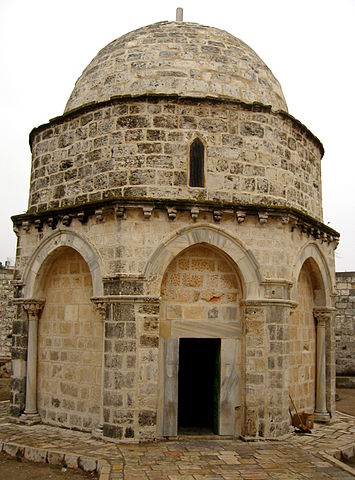Chapel of the Ascension
The Chapel of the Ascension is a shrine located on the Mount of Olives, in the At-Tur district of Jerusalem. Part of a larger complex consisting first of a Christian church and monastery, then an Islamic mosque, it is located on a site the faithful traditionally believe to be the earthly spot where Jesus ascended into Heaven forty days after his resurrection. It houses a slab of stone believed to contain one of his footprints.
Shortly after the death and resurrection of Jesus, early Christians began gathering in secret to commemorate his Ascension at a small cave on the Mount of Olives. The issuance of the Edict of Milan by the Roman Emperor Constantine I in 313 made it possible for Christians to worship overtly without fear of government persecution. By the time of the pilgrim Egeria’s travels to Jerusalem in 384, the spot of veneration had been moved to the present location, uphill from the cave. Saint Helena, mother of Constantine I, traveled to the holy land between 326 and 328. During her pilgrimage, she identified two spots on the Mount of Olives as being associated with Jesus’ life. The place of his Ascension, and a grotto associated with his teaching of the Lord’s Prayer. On her return to Rome she ordered the construction of two sanctuary complexes at these locations. According to legend, during the 5th century Saint Pelagia of Antioch lived here as a hermit and penitent in a grotto.
The main structure of the chapel of the Ascension is from the Crusader era; the octagonal drum and stone dome are Muslim additions. The exterior walls are decorated with arches and marble columns. The entrance is from the west, the interior of the chapel consists of a mihrab indicating the direction of Mecca in the south wall. On the floor, inside a stone frame, is a slab of stone called the “Ascension Rock”.
Ascension rock

The main octagonal ædicule surrounds the Ascension rock, said to contain the right footprint of Christ., the section bearing the left footprint having been taken to the Al-Aqsa Mosque in the Middle Ages. The faithful believe that the impression was made as Jesus ascended into Heaven and is venerated as the last point on earth touched by the incarnate Christ.
Burial crypt
The grounds also contain a burial crypt near the chapel that is revered by three separate monotheistic religions, although opinion differs on the occupant. Jews believe it contains the 7th-century BC prophetess Huldah, Christians believe it to be the tomb of the 5th-century saint Pelagia of Antioch; while Muslims maintain that the 8th-century Sufi mystic and Wali, Rabi’a al-Adawiya is buried there.
Source : wikipedia
https://www.youtube.com/watch?v=x-kfOYDNgjQ
https://www.youtube.com/watch?v=Ym9-ciZVSDw
https://www.youtube.com/watch?v=dzd1azBo_Cs
Reviews
https://goo.gl/xxt8vW



Rate this article